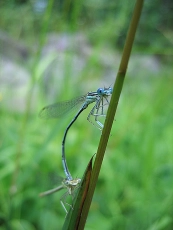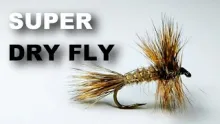An old, no-fashion dry fly. The one, that GFF partner Kasper tied right after having learned to tie the Red Tag Palmer and the one, that gave him many of his first dry fly experiences some twenty years ago, when it all started for him together with his grandfather.
Summer time in Sweden
We, my grandmother, grandfather and I were in Sweden in our small family summer cabin.
It was an old cabin. Not that small when I recall the memory. The old stoves from 1800-something were the only heaters in the house. All cooking was until recent done on one of them where the temperature was regulated by metal rings and by the amount of wood of course. My grandmother hated cooking on it, but that's another story.
The summer cabin was our base camp during many vacations in my childhood and youth.
It was located in the forest, a few kilometers from both lakes and streams.
We fished these nearby waters primarily using lures and spinners. The main targets were pike and perch (fried on a pan with new potatoes, butter and salt they are a delicacy).
From time to time we also used worms or dough to make a fish pull down our floaters, but on this sunny day my granddad unpacked a new rod - a fly fishing rod.
The first
I looked at the rod with a feeling of "I also want one" and "What should he be using it for? - or me?"
We spooled on the backing and the DT-line. Threw the leader away and made a few ourselves. We tied on a small tuft of yarn and my grandfather went down to the small flowering fields surrounded by pine trees. Butterflies escaped from the grass as he made his way to his starting point. A few rocks and a bush made the perfect training target.
He pulled out some line and started swinging the rod. In the beginning it did not look good, but I was eager to try and see if it really was that difficult. However, the rod was not for loan.
The day went by and not even at lunch I managed to get a single cast. My granddad continued casting, casting, casting.... casting and casting. He managed to do some corrections and he was in a good mood when it was time to sit by the table and have dinner - again.
The next day I was offered the rod for a couple of hours as the grands wanted to go to the town.
Hmmm... It was not that difficult to control the line, but to get the line out and still control it was much more difficult I’d better stick to my fly tying - Yes, I had been tying flies for the past two years, just for fun. I did not have the money for a fly rod anyway.
Jens, my granddad, did not bring the fly rod to the water for the whole week, but when we got back home, I picked strawberries in a fruit plantation, painted a whole farm house and cleaned lots of sheep houses, just to get money, so I could buy my own rod.
And I got one!
I also got a book by a Danish biologist Steen Ulnits. "Fluebinding 1" Fly Tying 1. For that time, it was an inspiring book with photos in black and white and stories from Steen’s first years as a fly fisher in the streams near the German border. It included step-by-steps photo series of such classics as Red Tag, Red Tag dry, Red Tag Palmer, Bloody Butcher and a Brown Spinner.
The last
My grandparents had lots of hens and cocks on their small farm. The cocks delivered good quality hackles even though some of them had quite long fibers. We did not care, and many of our flies floated high in the surface.
In our home stream, we fished for browns, as the only people, I guess. We never saw other dry fly anglers.
We only met other rod holders at dawn.
Sea trout! That was what they were fishing for.
We fished during the mornings, days and evenings and had the whole stream to ourselves. We enjoyed it very much and wandered kilometer after kilometer spotting feeding fish. Casting, drifting - kind of sight fishing in an unclear Danish stream. And we tied flies. Hundreds. The grass, trees, bushes, branches on the banks were by far the Top 5 of our catches and we lost many, many flies to them. It could be frustrating to see a newly tied fly on a brand new leader fix itself to a branch in the first cast. The only thing I got back was a curled useless leader. I replaced the tippet, tied on a new spinner and "smack!" - It disappeared somewhere in the grass behind me.
However, the joy of casting the fly and see it disappear in a small ring overshadowed the frustrations by an order of magnitude.
As my grandfather's legs got weaker he enjoyed sea trout fishing more. Two steps, one cast. Two slow steps, one cast. But I continued tying brown spinners
I tried several other patterns, like the Red Tag Dry, some flies I had bought and some blacks, whites etc. None worked as well as The Brown Spinner and it was and still is my all time favorite for these streams.
For years it has been the only dry fly I use when I visit my home waters and it still works. It brings back lots of memories of my granddad and me fishing... that might be the most important aspect of this fly has since we have cast the last cast together.
As I am writing this, it is June. During the summer vacation I might go to my home stream again. Walking along the bank, equipped with light gear, a spool of 6X tippet and a film canister of Brown Spinners. Maybe a red dotted brownie will follow the fly for a second and then,,,
Tying instructions
The Brown Spinner is a very, very simple dry fly. I know several people who have tied a dry Red Tag as their first dry because of its simplicity, but take a look at this. Maybe that's the first lesson fly.
- Log in to post comments

































Gregg,
good to kn
Gregg,
good to know that GFF inspires you and keeps you motivated and dreaming. I hope your shoulder pains will disappear soon, so you can go testing a Brown Spinner or two.
Kasper
Kasper,
Your eloque
Kasper,
Your eloquence in writing coupled with your wonderful photographs help set this site apart. Kudos for a great story and pattern. That fly would do well for a whole variety of mayfly species here in Idaho, as it is especially for the Pale Morning Dun, Ephemerella inermis, infrequens, spinner-as well as others common here. As an aside, still trying to heal from rotator cuff injuries so no fishing, (so frustratung,) but my tying has expanded greatly by perusal of this site. Am anxious to try some flies learned from your selections on our trout, whitefish, and other fish here.
Again, great read! Gregg
A nice, simple patte
A nice, simple pattern I find easy to tie and quick. Now for the trout!
What a great story.
What a great story. Brought back many memories of my Grandfather and I fishing for native rainbows on the stream that meandered along the property when I was a child.
The Brown Spinner looks like it would be very effective here, and so I see some tying for my weekend. Though my Grandfather has been gone for many years now, I think he'll be trying them out with me.
Good work Kasper!! C
Good work Kasper!! Could work on the Lima Stream!!
Nice tie, and a good
Nice tie, and a good story for it. Reading it brought back fond memories of fishing with my grandfather, stuff I had forgotten about, Thank you
Amazing pictures, br
Amazing pictures, brilliant tie.
Thanks guys. It's al
Thanks guys. It's always nice to get feed-back.
VERY NICE TIE!
VERY NICE TIE!
A wonderful story, f
A wonderful story, friend.
I might tie up a few Red Spinners and give them a drift or two along a stream I love.
Thanks,
Alan